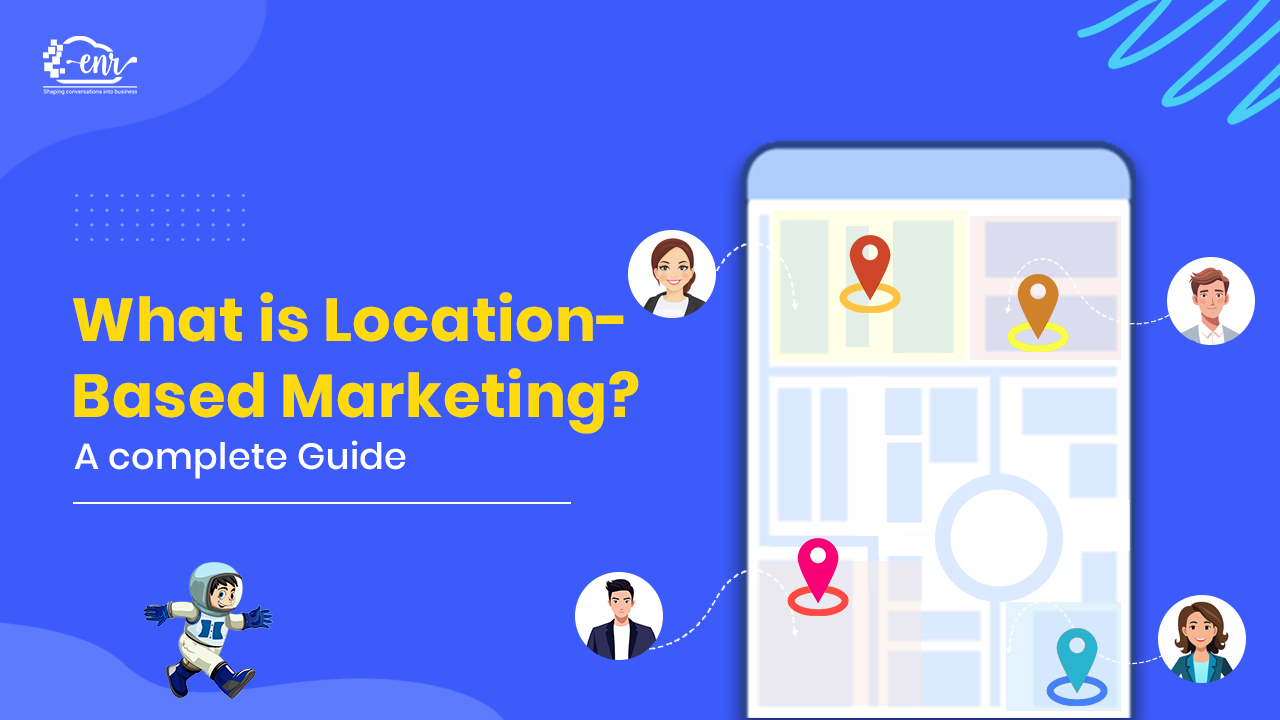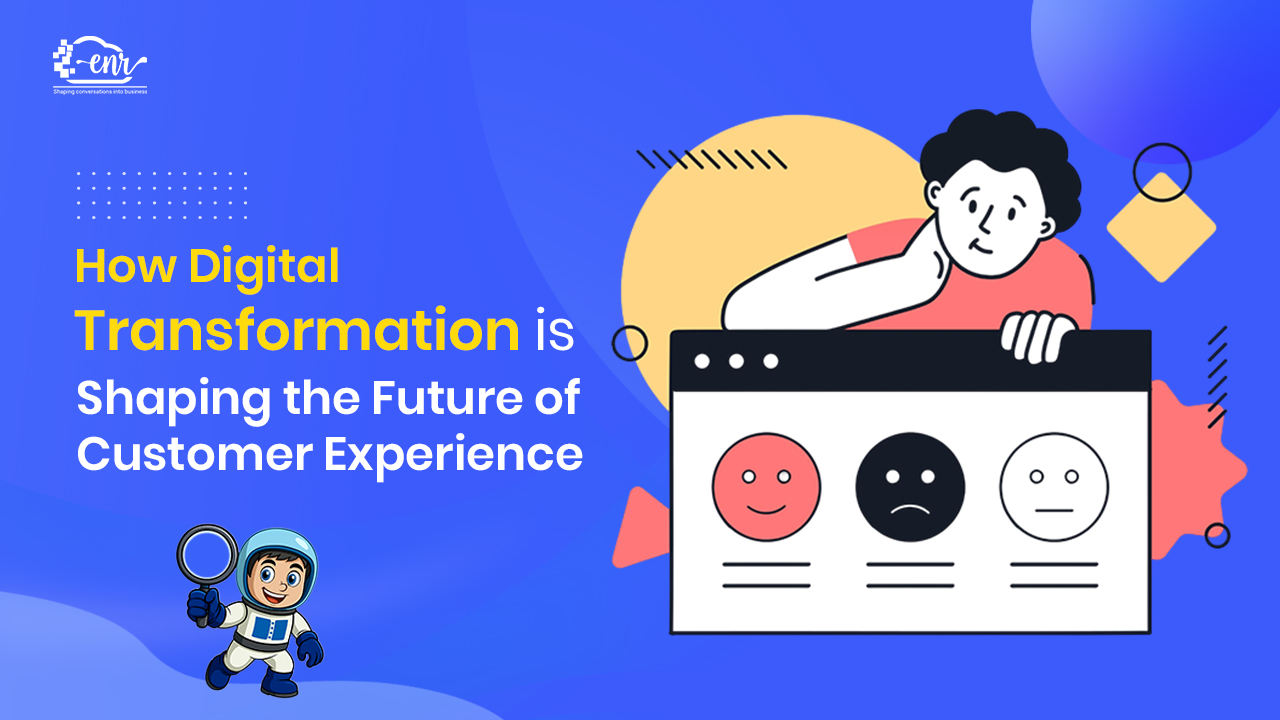Have you ever wondered how some brands can exactly tell where you are and what you really need? That is location-based marketing magic.
Just imagine passing by a coffee shop and receiving an irresistible notification for “Buy 1, Get 1 Free” exactly at the moment when you were craving caffeine.
Coincidence? Not quite.
That is a powerful marketing strategy that would connect the virtual world to the physical world to deliver hyper-relevant messages.
In this guide, we’ll uncover everything about location-based marketing—from its types and benefits to its challenges and trends. By the end, you’ll know how to leverage it like a pro.
Table of Contents
ToggleWhat is Location-based Marketing?
A location-based marketing strategy helps businesses target their audience with online and offline messaging based on their physical location. Using location-based marketing helps you reach users where they are with your marketing campaign.
Location-based marketing will successfully help you touch users in their customer journey from discovery to engagement and retention.
For example:
A customer who’s walking past your store, by using location-based marketing you can send them a push notification with a 15% discount code, encouraging them to step inside the store.
Similarly, an online retailer can use geotargeting to display ads relevant to a customer’s region, improving engagement and sales.
It’s all about being where your customers are—literally.
Type of Location-based Marketing
The main components of location-based marketing are :
Geotargeting
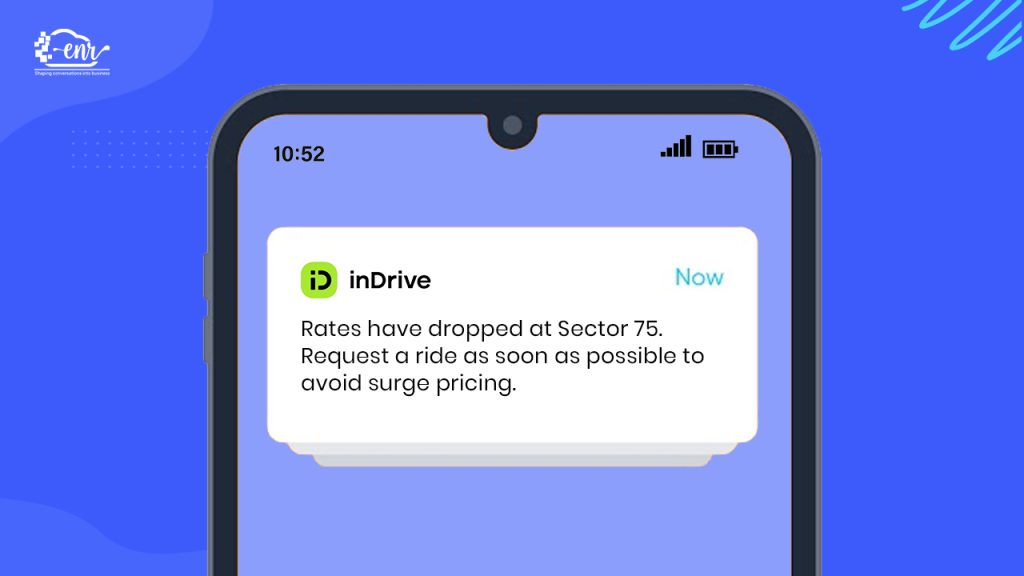
In geotargeting location-based marketing users are determined based on their real-time location or past visits, to serve them with customized and personalized marketing content.
Geotargeting delivers personalized content based on broader geographic data, such as city, state or ZIP code.
To receive the location-based message on the app or in push notification users need to opt-in and turn on the location access for a particular brand.
Example: Food delivery app offering free delivery to customers only if they fall into a specific zip code.
Geofencing
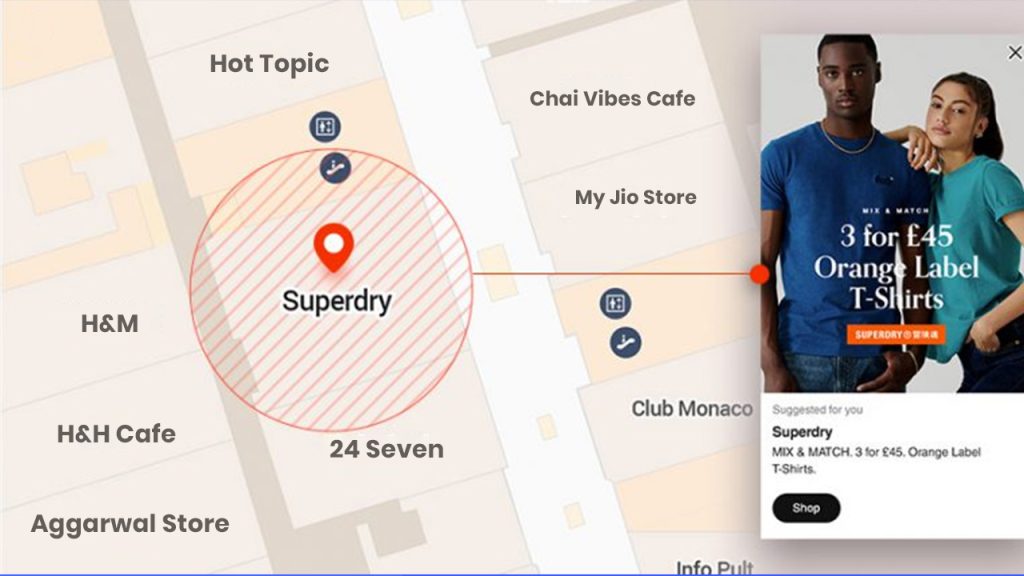
In geofencing location-based marketing users are targeted based on the virtual boundary around specific locations.
When a user enters this boundary they will become an active target audience for the marketing campaign strategy. It will help the brand make a real-time engagement with potential customers near your location.
This includes receiving a discount, content offers or any kind of message from a brand as soon as they are in the targeted location.
Example: A coffee shop sends a “Buy One Get One Free” offer to the customer within the virtual boundary of a 1-mile radius.
Beaconing
Beacons are small devices that use Bluetooth technology to detect devices and send personalized messages in specific areas. It works well when you want to target your existing customers within a small geographical area. Perfect for hyper-personalized in-store experiences.
Example: A bookstore notifies loyal customers about a sale on new arrivals when they’re nearby.
Mobile Targeting
Mobile targeting location-based marketing delivers ads based on their current location via mobile apps or web browsers.
While targeting with mobile device location, you need to be very specific as users tend to avoid advertising and if brands fail to provide a message without context, it may be spamming.
Precision is key here to avoid overwhelming users with irrelevant ads.
Example:
A shopping mall uses mobile targeting to share exclusive offers during festive seasons.
Geo-Conquesting
Geo-conquesting location-based marketing strategy, used to target customers visiting competitors’ locations to redirect them to your brands.
For example: McD offers discounts to customers near Burger King outlets to attract their footfall.
Instant coupons and offers can be used to capture market share and win over competitors’ customers.
Benefits of Location-Based Marketing
Personalization
Location-based marketing can customize the messages based on the users’ preferences, habits and immediate surroundings which helps you increase engagement.
- Examples: A fitness app sending a personalised workout recommendation based on the user’s local weather.
Increase Conversion Rates
Customers are more likely to react to messages that are relevant to the location they are and when they are in immediate need.
- Example: A restaurant offering a discount coupon to users who are near their restaurant during lunchtime.
Increase in Foot Traffic
Location-based marketing targets the user in proximity to physical stores, businesses can drive in-store visits and increase sales.
Read Also: 10 Customer Engagement Metrics You Need to Track
- Example: A retail store offering an exclusive in-store offer to app users within walking distance.
Enhanced Data Insights
Location data provides valuable insights into customer behavior, such as shopping patterns and preferred locations.
- Example: A clothing brand analyzes foot traffic data to identify peak shopping hours and optimize store staffing.
Cost-Effective Advertising
By focusing on specific audiences, location-based marketing reduces ad spend wastage.
- Example: A local bakery targets nearby customers with ads, avoiding broader, less relevant audiences.
Challenges of Location-Based Marketing
While location-based marketing offers exciting opportunities, it’s not without its challenges. Privacy concerns and technical limitations are a few hurdles businesses need to look into thoughtfully to make sure their campaigns remain effective, ethical, and relevant.
Privacy Concerns: Gaining Users’ Trust
Data privacy is a concern for many users, which is why they are wary of sharing their location data with brands. Customer fear being tracked or worse, their location information being abused by handlers or by third parties.
Why It’s A Challenge:
- People tend to protect their private lives, and thus avoid giving their sensitive details.
- There are also possibilities of vague understanding with regard to how data will be used, this would create mistrust.
Solution:
- Transparency is Key: Make it clear why you need people’s location, as well as its benefits for the user. For instance, “Enable location to find exclusive deals near you.”
- Opt-In Consent: Make it as easy, respectful, and private as possible to get opt-in consent. People should also be provided with an option to opt-out at any time.
- Data Security: Have strong data security measures in place in such a way that it will give confidence to the consumer on how you will secure his or her data and that the location won’t be used for anything other than where it was given consent.
Accuracy Issues: Targeting Gone Wrong
Essentially, location-based marketing’s success depends on the accuracy of collected data. However, employing tools like GPS or even a signal from a Wi-Fi access point may even sometimes show incorrect location data.
For example: Just walking past a store makes the user look like he is visiting it, or worse, a person may activate a marketing campaign that appears to be irrelevant to them.
Why It’s A Challenge
- Inaccurate data enables irrelevant or mistargeted marketing campaigns.
- Misinterpretation of a user’s location creates wasted time and money spent and irritates the audience
Solution
- Advanced Tools: It uses advanced technologies like beacons and geofencing polygons to create very precise boundaries. These locations keep track of micro-locations, like an aisle in stores or a specific parking space, as opposed to broad, radius-based forms of targeting.
- Real-time Updates: Continuously monitor and improve location data for real-time purposes to minimise errors.
- Behavioural Context: Combine location data with user insights for behaviours to ensure meaningful messaging.
Ad Fatigue: The Fine Line Between Engagement and Annoyance
One of the biggest risks of location-based marketing is overwhelming users with frequent, irrelevant notifications. When users feel bombarded, they are likely to disengage or even uninstall apps. Striking a balance between relevance and frequency is crucial to avoid annoying your audience.
Why It’s a Challenge:
- Too many notifications dilute the effectiveness of each message.
- Poorly timed or irrelevant messages feel intrusive, damaging brand reputation.
Solution:
- Prioritize Relevance: Send a message only when it brings meaningful value. For instance, “50% off lunch” sake makes sense around noon but adds no value at midnight–it will most likely only annoy users
- Set Frequency Caps Frequency Caps: Tools must be set up so that each location-based notification has a frequency cap per user, such as once every day or week.
- Segment Your Audience: Instead of blanket messaging, identify those users who are most likely to engage with certain specific offers.
Limited Reach: Leaving Out the Offline Audience
Location-based marketing, by its very nature, revolves around smartphones and app installations. Not every potential customer possesses a smartphone and, in quite many cases, individuals shy away from applications requesting access to their location. But then this confines the reach of marketing campaigns and leaves certain demographics uncovered.
Why It’s a Challenge:
- Cannot reach non-smartphone users or privacy-conscious individuals.
- Heavy reliance on apps enables campaigns for tech-savvy folks only.
Solution:
- Approach to include Multi-Channel Marketing: Complement location-based strategies with SMSs and emails while eyeing offline advertising for wider audience coverage. A store, for instance, discounting its products could complement app notifications with SMS blasts to local customers.
- Loyalty Programs: Encourage users to install apps by creating exclusive loyalty rewards for which location-based marketing can be tied together.
- Static Location Data: Use fixed-location tactics like signage or in-store beacons for walk-in customers without smartphone access.
When to Use Location-Based Marketing:
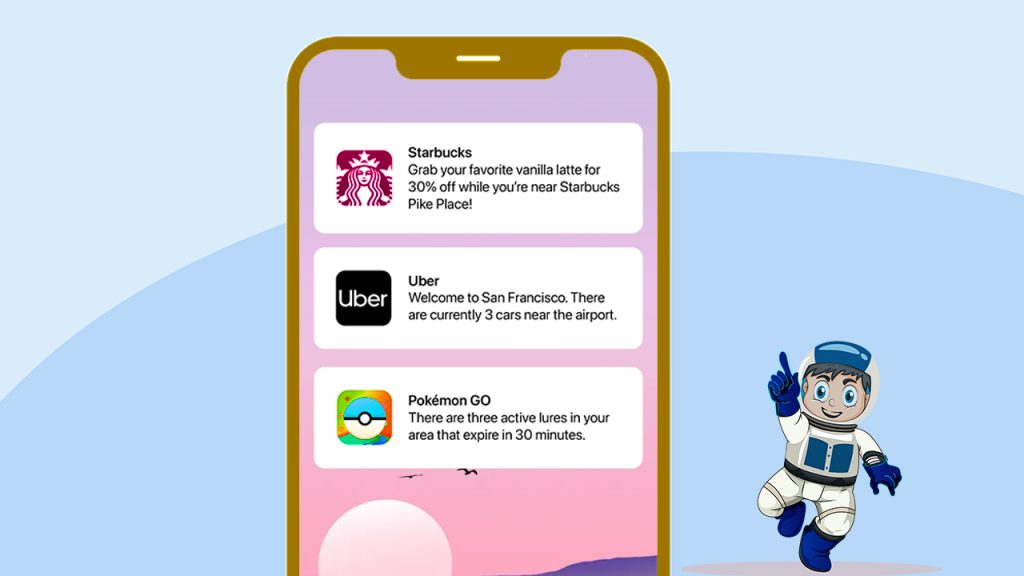
Location-based marketing is most effective when it is related to the particular needs of a business and uses real-time data and behavioral data to create personalized experiences.
Location-based marketing is ideal for retailers, grocery stores and restaurants for reclaiming lost customers through past data of customers who visited the site. It is also great for targeting people during daily commutes for weather-related campaigns that immediately engage the audience.
Businesses can use this advanced geo-conquesting to draw customers away from competitors, synchronize promotional offerings with location-based events, and even devise hyper-local clearance offers for inventories.
In short, it contributes to better targeting in industries such as retail, hospitality, and transport as it combines accurate tools like geofencing and beacons with behavioural segmentation.
When correctly applied, it delivers engagement, conversion and long-term relationship building.
Final Thought
Location-based marketing goes beyond targeting—it’s about creating meaningful, context-driven interactions that align with where your customers are and what they need at the moment. By harnessing precision tools and real-world insights, businesses can stay relevant, foster loyalty, and turn proximity into opportunity.
Read Also: The power of Marketing Automation to Convert Leads into Loyal Clients
Written By – Alisha Limichana
Alisha Limichana is a seasoned growth marketer and part of the MCG team at EnR Cloud, specializing in driving business growth through innovative strategies. She has a proven track record of delivering impactful marketing campaigns. Outside of work, Alisha enjoys exploring the mountains, travelling, and staying active and fit.

